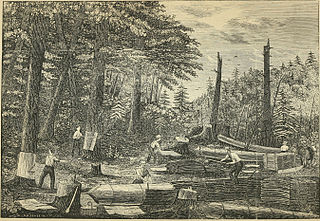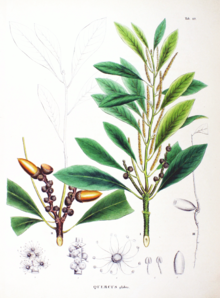
Onobrychis, the sainfoins, are Eurasian perennial herbs of the legume family (Fabaceae). Including doubtfully distinct species and provisionally accepted taxa, about 150 species are presently known. The Flora Europaea lists 23 species of Onobrychis; the main centre of diversity extends from Central Asia to Iran, with 56 species – 27 of which are endemic – in the latter country alone. O. viciifolia is naturalized throughout many countries in Europe and North America grasslands on calcareous soils.

Tannins are a class of astringent, polyphenolic biomolecules that bind to and precipitate proteins and various other organic compounds including amino acids and alkaloids.

The chestnuts are a group of eight or nine species of deciduous trees and shrubs in the genus Castanea, in the beech family Fagaceae. They are native to temperate regions of the Northern Hemisphere.

The persimmon is the edible fruit of a number of species of trees in the genus Diospyros. The most widely cultivated of these is the Oriental persimmon, Diospyros kaki. Diospyros is in the family Ebenaceae, and a number of non-persimmon species of the genus are grown for ebony timber. In 2019, China produced 75% of the world total of persimmons.
KE, ke, and variations may refer to:
Proanthocyanidins are a class of polyphenols found in a variety of plants such as blueberry. Chemically, they are oligomeric flavonoids. Many are oligomers of catechin and epicatechin and their gallic acid esters. More complex polyphenols, having the same polymeric building block, form the group of tannins.

Diospyros kaki, the Oriental persimmon, Chinese persimmon, Japanese persimmon or kaki persimmon, is the most widely cultivated species of the genus Diospyros. Although its first botanical description was not published until 1780, D. kaki is among the oldest cultivated plants, having been in use in China for more than 2000 years.

Procyanidins are members of the proanthocyanidin class of flavonoids. They are oligomeric compounds, formed from catechin and epicatechin molecules. They yield cyanidin when depolymerized under oxidative conditions.

Tanbark is the bark of certain species of trees. It is traditionally used for tanning hides into leather.

Acorn noodle soup, called dotoriguksu in Korean, is a noodle soup consisting of Korean noodles made from acorn flour or starch, salt, and a combination of grain-based flour.

The phenolic content in wine refers to the phenolic compounds—natural phenol and polyphenols—in wine, which include a large group of several hundred chemical compounds that affect the taste, color and mouthfeel of wine. These compounds include phenolic acids, stilbenoids, flavonols, dihydroflavonols, anthocyanins, flavanol monomers (catechins) and flavanol polymers (proanthocyanidins). This large group of natural phenols can be broadly separated into two categories, flavonoids and non-flavonoids. Flavonoids include the anthocyanins and tannins which contribute to the color and mouthfeel of the wine. The non-flavonoids include the stilbenoids such as resveratrol and phenolic acids such as benzoic, caffeic and cinnamic acids.

Condensed tannins are polymers formed by the condensation of flavans. They do not contain sugar residues.

Quercus infectoria, the Aleppo oak, is a species of oak, bearing galls that have been traditionally used for centuries in Asia medicinally. Manjakani is the name used in Malaysia for the galls; these have been used for centuries in softening leather and in making black dye and ink. In India the galls are called majuphal among many other names.
Chrysocercops castanopsidis is a moth of the family Gracillariidae. It is known from Japan.
Acrocercops unistriata is a moth of the family Gracillariidae. It is known from China, Hong Kong, Japan, Nepal and Taiwan.

Notholithocarpus densiflorus, commonly known as the tanoak or tanbark-oak, is a broadleaf tree in the family Fagaceae, native to the western United States, in California as far south as the Transverse Ranges, north to southwest Oregon, and east in the Sierra Nevada. It can reach 40 m (130 ft) tall in the California Coast Ranges, and can have a trunk diameter of 60–190 cm (24–75 in).

Cucurbitacin E is a biochemical compound from the family of cucurbitacins. These are found in plants which are member of the family Cucurbitaceae, most of them coming from traditional Chinese medicinal plants, but also in other plants such as pumpkins and gourds.
Lithocarpus encleisacarpus is a tree in the beech family Fagaceae. The specific epithet is from the Greek meaning "enclosed fruit", referring to the acorns and cupules. The cupule is not fused to the nut though and often becomes irregularly dehiscent. The degree to which the nut is enclosed by the cupule varies across its geographic range. Trees in Lithocarpus are commonly known as the stone oaks and differ from Quercus primarily because they produce insect-pollinated flowers.
Lithocarpus hystrix is a tree in the beech family Fagaceae. The specific epithet hystrix is from the Greek meaning "spiny", referring to the cupule.













